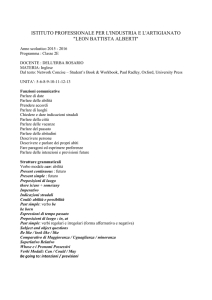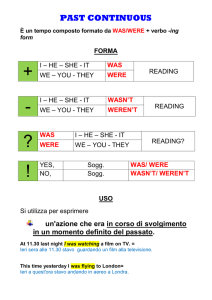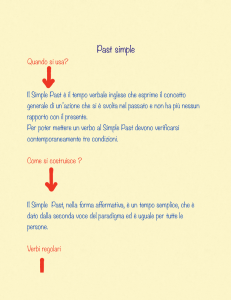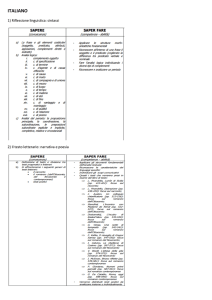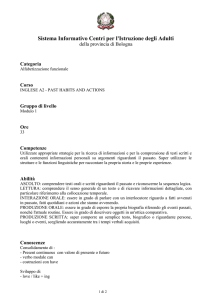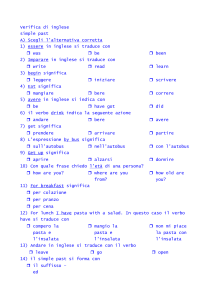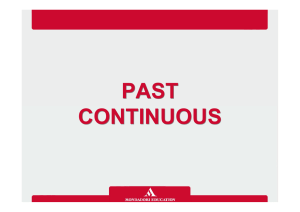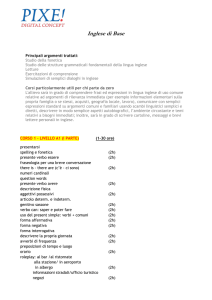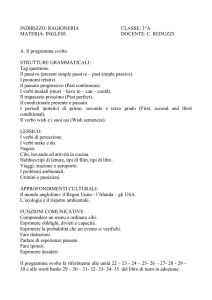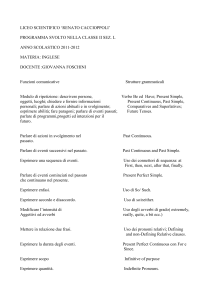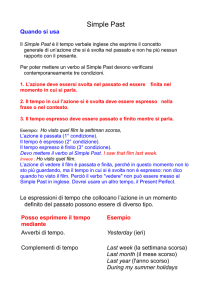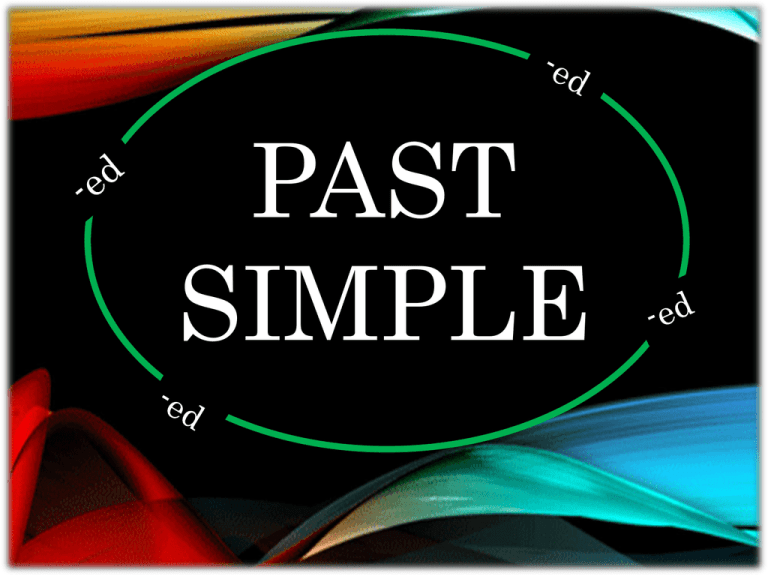
PAST
SIMPLE
Forma affermativa:
soggetto
+was/were…
-I was,
You were,
He/she/it was,
We were,
You were,
They were.
Forma negativa
contratta/estesa:
Soggetto+ wasn’t (was+
not) weren’t (were+not)…
-I wasn’t (n’t: not),
You weren’t (n’t: not),
He/she/it wasn’t (n’t: not),
We weren’t (n’t: not),
You weren’t (n’t: not),
They weren’t (n’t: not).
Forma interrogativa: Risposte brevi:
Was/Were+ Soggetto
Yes+ Soggetto+ Was/Were
-was I…?
Were You…?
Was He/she/it…?
Were We…?
Were You…?
Were They…?
I/He/She/It
Was
-Yes,
You/We/They Were
No+ Soggetto+ Wasn’t/Weren’t
I/He/She/It
Wasn’t
-No,
You/We/They Weren’t
Il Past Simple corrisponde al
passato remoto (fui), al passato
prossimo (sono stato) e
all’imperfetto (ero) in italiano.
IL PAST SIMPLE
Il Past Simple si usa
per parlare di azioni o
situazioni avvenute e
concluse nel passato.
In Inglese si usa il Past
Simple del verbo BE per
dire quando si è nati:
Es. I WAS BORN in 2003;
Io SONO NATO nel 2003.
Gli anni fino al 1999 si leggono dividendo il numero in
due coppie di cifre:
-1995 ninteen ninety-five
-1900 ninteen hundred
-1905 ninteen oh five
A partire dall’anno 2000, invece, i numeri si leggono:
-2000 two thousand
-2001 two thousand and one
SI SCRIVE
SI DICE
26th March
The twenty-sixth of March
March 26th
March the twenty-sixth
ECCO ALCUNE
REGOLE
ORTOGRAFICHE
IMPORTANTI…….
-ed
I walked
You walked
He walked
She walked
It walked
We walked
You walked
They walked
Il Past Simple ha una sola forma,
indicata per tutte le persone.
Es.
• Per i verbi regolari la forma
affermativa del Past Simple si
costruisce aggiungendo –ed alla
forma base del verbo;
• Ci sono alcune regole ortografiche da
ricordare quando si aggiunge –ed alla
forma base.
Forma base del verbo
Past Simple
Verbi che terminano in -ed
+d
like
liked
Live
Lived
Prepare
prepared
Forma base del verbo
+ed
Play
Played
Stay
Stayed
Enjoy
Enjoyed
Forma base del verbo
Mono/bisillabi che terminano in
vocale accentata + consonante
Past simple
Verbi che
Y+ -ied
terminano in
consonante
+ -y
Past Simple
Verbi che terminano in vocale
+ -y
Forma base
del verbo
marry
Married
Study
studied
try
tried
Past Simple
Raddoppia la consonante più -ed
stop
Stopped
Prefer
preferred
Travel
Travelled
LA PRONUNCIA
Ci sono 3 modi per leggere la –ED finale del Simple
Past, dipende dalla fonetica delle consonanti che lo precedono:
1) ED si pronuncia con una T se il verbo finisce con questi «unvoiced
sounds» (suoni non sonori):
K P f(gh) S(s-se-ce) l(sh) tl(ch)
Esempi:
K: asked-booked-checked-liked-smoked-walked-worked
P: Hoped
f: laughed
S: Danced-missed-passed-practised-pronounced-unvoiced-voiced
l (sh): finished-washed
tl (ch): touched-watched
Do =Did
Forma interrogativa
DID
SOGGETTO
FORMA BASE
DEL VERBO
I/He/She/It
DID
Play?
We/You/They
Risposte brevi
I/He/She/It
YES
Did
We/You/They
I/He/She/It
NO
Didn’t
We/You/They
……………NO,…DIDN’T………......
How………………………….?
How aggettivo…?
How tall…?
How high…?
How deep…?
How long…?
How wide…?
How far…?
How heavy…?
Nelle risposte far e heavy
non si ripetono?
soggetto
be
Unità di
misura
aggettivo
Mark
Is
1 metre
TALL.
The pool
Is
3 metres
DEEP.
It
Is
60 kms.
They
are
10kgs.
HEAVY
Eccezioni alla
forma
affermativa…
I verbi irregolari cambiano alla SOLO alla forma affermativa.
Ci sono delle eccezioni
in cui il verbo rimane invariato
Translation
Infinitive
Past
Simple
Translation
infinitive
Past
Simple
Translation
infinitive
Past
Simple
Fare
Make
Made
Fare
Do
Did
Pagare
Pay
Paid
Andare
Go
went
Crescere
Grow
Grew
Correre
Run
Ran
Nuotare
Swim
Swam
Avere
Have
Had
Cantare
Sing
Sang
Dormire
Sleep
Slept
Sedere
Sit
Sat
Rubare
Steal
Stole
Leggere
Read
Read
Mettere
Put
Put
Mettere
Lay
laid
Incontrare
Meet
Met
Vincere
Win
Won
Indossare
Wear
Wore
Scrivere
Write
Wrote
Parlare
Speak
Spook
Raccontare
Tell
Told
GRAZIE PER LA VISIONE
PAST SIMPLE

